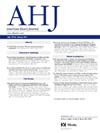Positive outcome trials driven by reduction in nonfatal myocardial infarction: A systematic review and relevant guideline recommendations
IF 3.7
2区 医学
Q1 CARDIAC & CARDIOVASCULAR SYSTEMS
引用次数: 0
Abstract
Background
To identify pharmacological randomized controlled trials (RCTs) with “positive” outcomes driven by nonfatal myocardial infarction (MI) reductions and assess related guideline recommendations.
Methods
RCTs published between 2000 and 2024 focusing on mortality and nonfatal MI were identified through searches in PubMed and Web of Science. Citation tracking was used to find trials referenced in clinical guidelines. The levels of guideline recommendations based on the supporting trials were summarized. The impact of nonfatal MI on composite outcomes was assessed by using the leave-one-out method.
Results
Of 21,005 records, 6 RCTs demonstrating positive outcomes due to nonfatal MI reduction were cited in current guidelines, including anti-thrombotic (3), intensive lipid-lowering (2), and anti-inflammatory (1) therapies. Intensive lipid-lowering trials (IMPROVE-IT, FOURIER; totaling 60 recommendations across 17 guidelines) were more frequently recommended in guidelines: 45% Class I, 33.3% Class IIa, and 21.7% Class IIb. Anti-thrombotic and anti-inflammatory trials had no Class I recommendations and higher Class IIb recommendations (66.7% and 100%). A meta-analysis including major intensive lipid-lowering RCTs on top of maximally tolerated statins (IMPROVE-IT, FOURIER, and ODYSSEY OUTCOMES) revealed no statistical difference in primary composite outcome after removing nonfatal MI events (relative risk 0.94, 95% confidence interval: 0.88-1.01).
Conclusion
In contemporary pharmacological RCTs with positive composite outcome driven by nonfatal MI reduction, intensive lipid-lowering trials are more frequently received strong guideline recommendations. This analysis underscores the need to evaluate whether these recommendations fully reflect the clinical significance of the observed benefits.

减少非致死性心肌梗死的积极结果试验:系统回顾和相关指南建议
背景:确定由非致死性心肌梗死(MI)减少驱动的具有“积极”结果的药理学随机对照试验(rct),并评估相关指南建议。方法通过PubMed和Web of Science检索2000年至2024年间发表的关注死亡率和非致死性心肌梗死的srct。引文跟踪用于查找临床指南中引用的试验。总结了基于支持试验的指南推荐水平。非致死性心肌梗死对综合结果的影响采用留一法评估。结果在21,005项记录中,6项随机对照试验显示非致死性心肌梗死减少的积极结果被引用到当前的指南中,包括抗血栓(3)、强化降脂(2)和抗炎(1)治疗。强化降脂试验(improved - it, FOURIER;17条指南共60条建议)在指南中被推荐的频率更高:45%为I类,33.3%为IIa类,21.7%为IIb类。抗血栓和抗炎试验没有I类推荐和更高的IIb类推荐(66.7%和100%)。一项荟萃分析包括在最大耐受他汀类药物基础上进行的主要强化降脂随机对照试验(改善- it、傅立叶和奥赛结局)显示,在去除非致命性心肌梗死事件后,主要综合结局无统计学差异(相对风险0.94,95%置信区间:0.88-1.01)。结论:在由非致死性心肌梗死减少驱动的阳性综合结果的当代药理随机对照试验中,强化降脂试验更经常得到强烈的指南推荐。该分析强调需要评估这些建议是否完全反映了观察到的益处的临床意义。
本文章由计算机程序翻译,如有差异,请以英文原文为准。
求助全文
约1分钟内获得全文
求助全文
来源期刊

American heart journal
医学-心血管系统
CiteScore
8.20
自引率
2.10%
发文量
214
审稿时长
38 days
期刊介绍:
The American Heart Journal will consider for publication suitable articles on topics pertaining to the broad discipline of cardiovascular disease. Our goal is to provide the reader primary investigation, scholarly review, and opinion concerning the practice of cardiovascular medicine. We especially encourage submission of 3 types of reports that are not frequently seen in cardiovascular journals: negative clinical studies, reports on study designs, and studies involving the organization of medical care. The Journal does not accept individual case reports or original articles involving bench laboratory or animal research.
 求助内容:
求助内容: 应助结果提醒方式:
应助结果提醒方式:


